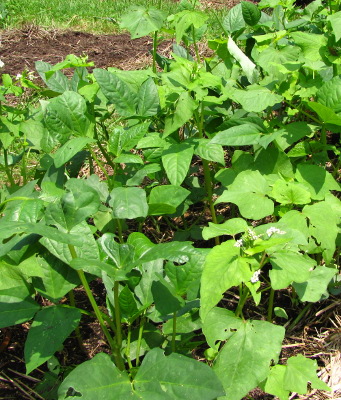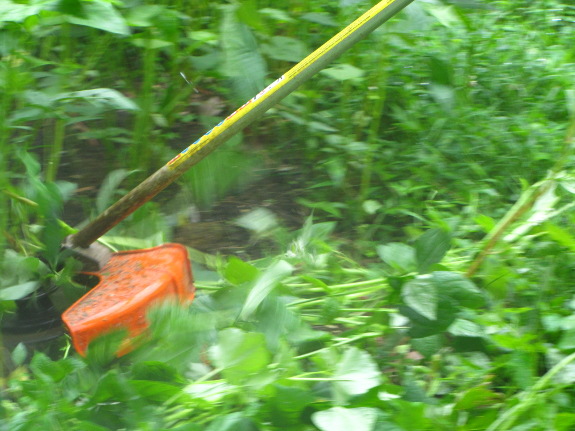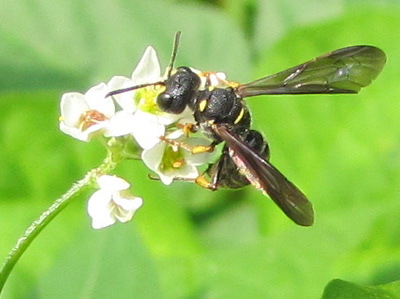
Quick summer cover crop: Cowpeas and buckwheat
 I've read that cowpeas and
buckwheat combined at one part cowpeas to two parts buckwheat make a
quick summer cover crop that
works well with no-till gardens. My trials (so far) agree.
I've read that cowpeas and
buckwheat combined at one part cowpeas to two parts buckwheat make a
quick summer cover crop that
works well with no-till gardens. My trials (so far) agree.
Last year, I tried out buckwheat
as our summer cover crop, and wasn't all that
thrilled, but I think that part of my disappointment was not
understanding what I should be expecting. Like other summer cover
crops that fit between the harvest of your spring crops and the
planting of your fall crops, buckwheat isn't going to add as much
organic matter to your soil as the more woody winter cover crops
will. Instead, buckwheat soaks up nitrogen that might otherwise
get leached out of
bare ground, keeping
the nutrient in circulation for your next crop, and the buckwheat stems
and leaves also break down quickly after being killed so that you don't
need to let your beds rest long before planting. Depending on
your climate, you can slip buckwheat into a four to six week gap in
your garden year, cutting it anywhere from when the flowers first
appear until one week after full bloom, and then waiting one to two
weeks before planting into the tiny bit of stubble that remains.

Adding cowpeas to the
buckwheat cover crop reduces your need to add a layer of compost before
seeding your fall garden since you greatly increase the amount of
available nitrogen produced. Like many legumes, cowpeas fix
nitrogen out of the air, and they do that even
better when there's very little nitrogen in the soil for them to suck
up. Buckwheat steals soil nitrogen from its neighbors, tricking
the cowpeas into fixing more nitrogen than they would if grown by
themselves in the same soil. You cut the duo at the same time you
would have cut the buckwheat (which is several weeks earlier than you
would normally cut cowpeas) and end up with somewhere between 50% to
100% of your nitrogen needs for the fall garden taken care of.
 Of course, cover crops have
other purposes besides adding nutrients and organic matter to the
soil. They slow down weed growth, prevent erosion, and (in the
case of buckwheat) attract masses of beneficial insects. The only
potential downside is if you have trouble killing them, but the
weedeater seems to have done a good job of demolishing nearly all of
the buckwheat and cowpeas with one pass. They're so easy to pull
up that I won't mind at all hand-weeding the few plants left behind.
Of course, cover crops have
other purposes besides adding nutrients and organic matter to the
soil. They slow down weed growth, prevent erosion, and (in the
case of buckwheat) attract masses of beneficial insects. The only
potential downside is if you have trouble killing them, but the
weedeater seems to have done a good job of demolishing nearly all of
the buckwheat and cowpeas with one pass. They're so easy to pull
up that I won't mind at all hand-weeding the few plants left behind.
Want more in-depth information? Browse through our books.
Or explore more posts by date or by subject.
About us: Anna Hess and Mark Hamilton spent over a decade living self-sufficiently in the mountains of Virginia before moving north to start over from scratch in the foothills of Ohio. They've experimented with permaculture, no-till gardening, trailersteading, home-based microbusinesses and much more, writing about their adventures in both blogs and books.
Want to be notified when new comments are posted on this page? Click on the RSS button after you add a comment to subscribe to the comment feed, or simply check the box beside "email replies to me" while writing your comment.

That's an excellent question, and I wish I had an excellent answer. (If you do find a better answer, I hope you'll comment with a link!)
I've been getting my cover crop information from a very good free pdf document that you can download here: http://www.sare.org/Learning-Center/Books/Managing-Cover-Crops-Profitably-3rd-Edition. (The print copy costs money, but if you scroll down, you can download the file for free.)
I've discovered that only a few cover crops work well with my no-till garden here in zone 6, and here are the planting dates I've developed for them. (You would tweak these if you live in a different zone.)
Buckwheat --- plant anytime between last frost and one month before first frost
Cowpeas --- plant between last frost and two months before first frost (or one month before first frost if you're mixing with buckwheat.)
Oats --- Plant August 1 through September 15 for a fall and winter cover that will be a mulch in spring.
Oilseed radish --- Plant August 1 through September 7 for a fall and winter cover that will disappear in mid spring.
Is it a good idea to plant a cover crop after EVERY production crop? or can you get by with just a winter cover ,IE, non-producing times.
You can use anywhere from no cover crops at all to whole fallow years with one cover crop after another to really rejuvenate the soil. How much of your garden area/time you want to devote to cover crops will probably depend on whether you've got good, loamy soil (in which case just adding compost every year will keep your levels of organic matter stable, or you might choose to slip in cover crops here and there) or soil that's badly in need of renovation.
Our growing area has highly variable soil conditions in different parts. In the worst zone, I'm planting one vegetable crop per year and then running one or two cover crops to try to build up the soil. That area has terrible drainage, so I'm especially focusing on oilseed radishes to break up the subsoil.
Another area has well-drained soil, but is primarily clay that's low in organic matter. It's my sunniest spot, so I focus on growing spring and fall crops there (and tomatoes) and slip my cover crops between the two in the summer. Sometimes I have beds that I won't be planting for the fall garden, in which case I plant oats to give the soil an extra heavy duty dose of organic matter.
My last area has the best soil but is too shady for anything except summer growing. I plant oats there to keep the soil well mulched over the long winter while also building biomass. If I happen to have a bare spot in the summer, I'll also toss in a summer cover crop, but I don't focus on them.
In general, think of cover crops as replacing part of your compost and/or mulch (depending on their C:N.) They add organic matter and keep the ground from being bare. I think it would probably be possible to keep a no-till garden going with no compost and mulch inputs if you grew enough cover crops, but that might mean using two or three times the growing area!
I am ready to try this! When you say one partcow peas two parts buckwheat - how do you measure that?
I'm thinking of braodcasting and then raking in about 1/2 cup of buckwheat seeds over a 40 sq ft row from which I just harvested potatoes. Then pushing in cowpeas - about one every sq ft? Does this make sense?